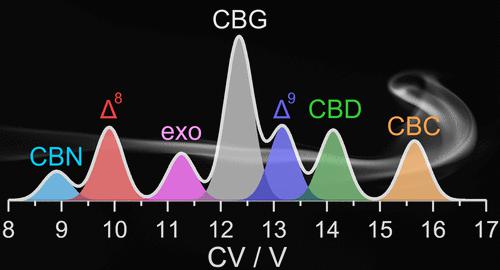当前位置:
X-MOL 学术
›
Anal. Chem.
›
论文详情
Our official English website, www.x-mol.net, welcomes your
feedback! (Note: you will need to create a separate account there.)
Argentination: A Silver Bullet for Cannabinoid Separation by Differential Mobility Spectrometry
Analytical Chemistry ( IF 6.7 ) Pub Date : 2023-05-24 , DOI: 10.1021/acs.analchem.3c01241 Christian Ieritano 1, 2, 3 , Patrick Thomas 1 , W Scott Hopkins 1, 2, 3, 4
Analytical Chemistry ( IF 6.7 ) Pub Date : 2023-05-24 , DOI: 10.1021/acs.analchem.3c01241 Christian Ieritano 1, 2, 3 , Patrick Thomas 1 , W Scott Hopkins 1, 2, 3, 4
Affiliation

|
As the legality of cannabis continues to evolve globally, there is a growing demand for methods that can accurately quantitate cannabinoids found in commercial products. However, the isobaric nature of many cannabinoids, along with variations in extraction methods and product formulations, makes cannabinoid quantitation by mass spectrometry (MS) challenging. Here, we demonstrate that differential mobility spectrometry (DMS) and tandem-MS can distinguish a set of seven cannabinoids, five of which are isobaric: Δ9-tetrahydrocannabinol (Δ9-THC), Δ8-THC, exo-THC, cannabidiol, cannabichromene, cannabinol, and cannabigerol. Analytes were detected as argentinated species ([M + Ag]+), which, when subjected to collision-induced dissociation, led to the unexpected discovery that argentination promotes distinct fragmentation patterns for each cannabinoid. The unique fragment ions formed were rationalized by discerning fragmentation mechanisms that follow each cannabinoid’s MS3 behavior. The differing fragmentation behaviors between species suggest that argentination can distinguish cannabinoids by tandem-MS, although not quantitatively as some cannabinoids produce small amounts of a fragment ion that is isobaric with the major fragment generated by another cannabinoid. By adding DMS to the tandem-MS workflow, it becomes possible to resolve each cannabinoid in a pure N2 environment by deconvoluting the contribution of each cannabinoid to a specific fragmentation channel. To this end, we used DMS in conjunction with a multiple reaction monitoring workflow to assess cannabinoid levels in two cannabis extracts. Our methodology exhibited excellent accuracy, limits of detection (10–20 ppb depending on the cannabinoid), and linearity during quantitation by standard addition (R2 > 0.99).
中文翻译:

阿根廷化:通过差分淌度光谱法分离大麻素的灵丹妙药
随着大麻的合法性在全球范围内不断发展,对能够准确定量商业产品中发现的大麻素的方法的需求不断增长。然而,许多大麻素的同量异位性质,以及提取方法和产品配方的变化,使得通过质谱法 (MS) 对大麻素进行定量具有挑战性。在这里,我们证明微分迁移率光谱法 (DMS) 和串联 MS 可以区分一组七种大麻素,其中五种是同量异位素:Δ 9 -四氢大麻酚 (Δ 9 -THC)、Δ 8 -THC、exo-THC、大麻二酚, cannabichromene, cannabinol, and cannabigerol. 分析物被检测为镀银物质 ([M + Ag] +), 当受到碰撞诱导的解离时, 导致意外发现, argentination 促进了每种大麻素的不同碎片模式。形成的独特碎片离子通过遵循每个大麻素的 MS 3行为的辨别碎片机制合理化。物种之间不同的碎片行为表明,阿根廷化可以通过串联 MS 区分大麻素,尽管不是定量的,因为一些大麻素产生少量碎片离子,该碎片离子与另一种大麻素产生的主要碎片同量。通过将 DMS 添加到串联 MS 工作流程中,可以解析纯 N 2中的每种大麻素通过将每种大麻素对特定碎片通道的贡献进行去卷积来了解环境。为此,我们将 DMS 与多反应监测工作流程结合使用,以评估两种大麻提取物中的大麻素水平。我们的方法展示了出色的准确性、检测限(10–20 ppb,取决于大麻素)和标准添加定量过程中的线性 ( R 2 > 0.99)。
更新日期:2023-05-24
中文翻译:

阿根廷化:通过差分淌度光谱法分离大麻素的灵丹妙药
随着大麻的合法性在全球范围内不断发展,对能够准确定量商业产品中发现的大麻素的方法的需求不断增长。然而,许多大麻素的同量异位性质,以及提取方法和产品配方的变化,使得通过质谱法 (MS) 对大麻素进行定量具有挑战性。在这里,我们证明微分迁移率光谱法 (DMS) 和串联 MS 可以区分一组七种大麻素,其中五种是同量异位素:Δ 9 -四氢大麻酚 (Δ 9 -THC)、Δ 8 -THC、exo-THC、大麻二酚, cannabichromene, cannabinol, and cannabigerol. 分析物被检测为镀银物质 ([M + Ag] +), 当受到碰撞诱导的解离时, 导致意外发现, argentination 促进了每种大麻素的不同碎片模式。形成的独特碎片离子通过遵循每个大麻素的 MS 3行为的辨别碎片机制合理化。物种之间不同的碎片行为表明,阿根廷化可以通过串联 MS 区分大麻素,尽管不是定量的,因为一些大麻素产生少量碎片离子,该碎片离子与另一种大麻素产生的主要碎片同量。通过将 DMS 添加到串联 MS 工作流程中,可以解析纯 N 2中的每种大麻素通过将每种大麻素对特定碎片通道的贡献进行去卷积来了解环境。为此,我们将 DMS 与多反应监测工作流程结合使用,以评估两种大麻提取物中的大麻素水平。我们的方法展示了出色的准确性、检测限(10–20 ppb,取决于大麻素)和标准添加定量过程中的线性 ( R 2 > 0.99)。











































 京公网安备 11010802027423号
京公网安备 11010802027423号